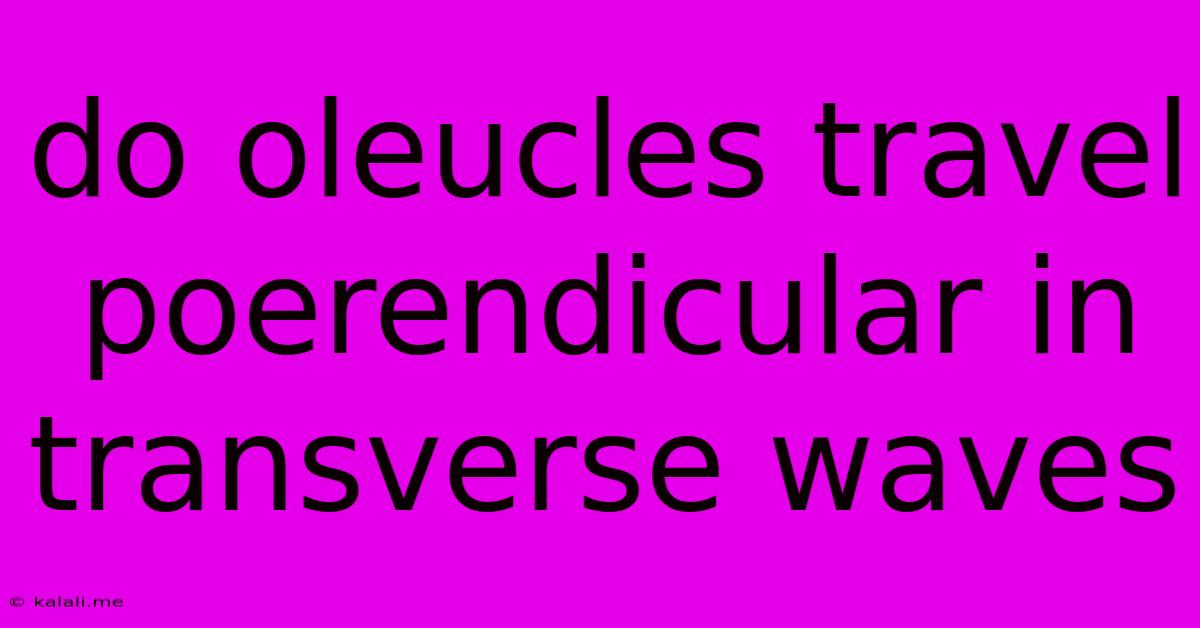Do Oleucles Travel Poerendicular In Transverse Waves
Kalali
Jun 08, 2025 · 3 min read

Table of Contents
Do Molecules Travel Perpendicular in Transverse Waves?
Meta Description: Understanding wave motion is crucial in physics. This article explores the behavior of molecules in transverse waves, clarifying whether they move perpendicular to the wave's direction. We'll delve into the mechanics of transverse waves, providing a clear explanation with examples.
Transverse waves are a fascinating area of physics, often visualized as ripples in water or the movement of a wave on a string. A common question arises: do the molecules themselves travel perpendicular to the direction of the wave? The short answer is no, the molecules oscillate perpendicular to the direction of wave propagation, but they don't travel along with the wave.
Let's break this down further. In a transverse wave, the particles of the medium (like water molecules or the segments of a string) vibrate or oscillate perpendicular to the direction the wave energy is traveling. This is the key difference between transverse and longitudinal waves. In longitudinal waves, like sound waves, the particles oscillate parallel to the direction of wave propagation.
Understanding Transverse Wave Motion
Imagine a rope. When you flick one end, a wave travels down the rope. The wave appears to move along the rope, but each individual segment of the rope only moves up and down (or sideways), perpendicular to the direction of the wave. The energy is transferred along the rope, not the rope itself moving along. This up-and-down motion is the oscillation we're discussing.
This same principle applies to other transverse waves:
- Electromagnetic waves: These waves, including light, radio waves, and X-rays, are transverse waves. However, they don't require a medium to travel; the oscillating components are electric and magnetic fields, perpendicular to each other and to the direction of wave propagation.
- Seismic S-waves: These are transverse waves that travel through the Earth during an earthquake. The ground itself oscillates perpendicular to the direction the wave is moving.
Why Molecules Don't Travel with the Wave
The misconception often stems from visualizing the wave's shape traveling. The wave's form propagates, but the individual molecules remain relatively close to their equilibrium position. Their displacement is limited to their oscillatory motion. Think of it like a Mexican wave in a stadium: the wave travels around the stadium, but individual spectators only move up and down in their seats.
The energy of the wave is transferred through the interaction between neighboring molecules. A molecule oscillates, transferring energy to the next molecule in the chain, causing it to oscillate, and so on. This transfer of energy is what constitutes the propagation of the wave.
Key Differences: Transverse vs. Longitudinal Waves
To solidify the understanding, let's compare transverse and longitudinal waves:
| Feature | Transverse Wave | Longitudinal Wave |
|---|---|---|
| Particle Motion | Perpendicular to wave direction | Parallel to wave direction |
| Example | Waves on a string, light waves, seismic S-waves | Sound waves, seismic P-waves |
| Medium Required | Usually requires a medium (except EM waves) | Requires a medium |
In conclusion, while molecules in a transverse wave oscillate perpendicularly to the wave's direction, they do not travel along with the wave itself. The wave's energy propagates through the interaction and oscillation of these molecules, creating the characteristic wave pattern. Understanding this distinction is fundamental to grasping the principles of wave mechanics.
Latest Posts
Latest Posts
-
How To Clean Rust Off Concrete
Jun 08, 2025
-
Whta Is Nbetter Cg Miner Or Bfg Miner
Jun 08, 2025
-
How To Get Rid Of Rabbits In My Yard
Jun 08, 2025
-
What Number Is The Only Even Prime Number
Jun 08, 2025
-
How To Get Food Coloring Out Of Your Hands
Jun 08, 2025
Related Post
Thank you for visiting our website which covers about Do Oleucles Travel Poerendicular In Transverse Waves . We hope the information provided has been useful to you. Feel free to contact us if you have any questions or need further assistance. See you next time and don't miss to bookmark.